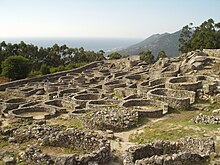Pontevedra is a spanish Province in the region Galicia. Your neighboring provinces are A Coruña in the North, Lugo and Ourense in the East. Southern neighbor is Portugal, in the east is the Atlantic ocean a natural limit.
.svg/400px-Pontevedra_in_Spain_(plus_Canarias).svg.png)
Regions
The province is mostly mountainous. Your coastline is one of the Rías Baixas, they are deeply cut valleys with beautiful beaches.
In the south is that Rio Miño Border river to Portugal, in the middle of the province the Rio Lérez at Pontevedra in the Atlantic. 'Between these two rivers is the most densely populated area with the most tourist attractions.
The population of the province is just under one million people, about one in three lives in Vigo, one in ten in Pontevedra.
places
&groups=Maske,Track,Aktivitaet,Anderes,Anreise,Ausgehen,Aussicht,Besiedelt,Fehler,Gebiet,Kaufen,Kueche,Sehenswert,Unterkunft,aquamarinblau,cosmos,gold,hellgruen,orange,pflaumenblau,rot,silber,violett)


- 1 Pontevedra
 is located on the Ría de Pontevedra, the mouth of the Lérez River, a strategically important port in the 16th century. The city is internationally known for its urbanity and pedestrian-friendliness.
is located on the Ría de Pontevedra, the mouth of the Lérez River, a strategically important port in the 16th century. The city is internationally known for its urbanity and pedestrian-friendliness. - 2 Sanxenxo
 is the "tourism capital" of the region Rías Baixas and the largest seaside resort in Galicia with a beautiful four kilometer long sandy beach.
is the "tourism capital" of the region Rías Baixas and the largest seaside resort in Galicia with a beautiful four kilometer long sandy beach. - 3 Vigo
 is an industrial city. It is home to the largest fishing fleet in the country.
is an industrial city. It is home to the largest fishing fleet in the country. - 4 Cambados
 , the center of viticulture (D.O. Albariño), is located on the estuary of the Ría de Arousa. Beautiful baroque mansions.
, the center of viticulture (D.O. Albariño), is located on the estuary of the Ría de Arousa. Beautiful baroque mansions.
- 5 A Guarda
 , the southernmost town in Galicia is famous for its lobster. Nearby is the Monte Santa Tecla with the excavations of a Celtic village from the 5th century BC. Chr.
, the southernmost town in Galicia is famous for its lobster. Nearby is the Monte Santa Tecla with the excavations of a Celtic village from the 5th century BC. Chr. - 6 Catoira
 , a small town on the Ría de Arousa. Their defenses were able to withstand attacks from Vikings and pirates several times. The festival of the Romeria Wikinga.
, a small town on the Ría de Arousa. Their defenses were able to withstand attacks from Vikings and pirates several times. The festival of the Romeria Wikinga. - 7 Tui
 (span. Tuy), border town to Portugal on the right bank of the Rio Miño. Worth seeing is the fortified cathedral, it dates from the 12th / 13th centuries. Century. The Portuguese city is on the other side of the river Valença. Today the places are connected by an iron bridge constructed by Gustave Eiffel, among other things.
(span. Tuy), border town to Portugal on the right bank of the Rio Miño. Worth seeing is the fortified cathedral, it dates from the 12th / 13th centuries. Century. The Portuguese city is on the other side of the river Valença. Today the places are connected by an iron bridge constructed by Gustave Eiffel, among other things.
Other goals
- The Islas Cíes are a small group of islands at the mouth of the Ría de Vigo. In 1980 the Islas Cíes were declared a nature reserve. The archipelago has been part of the national park since 2002 Parque nacional de las Islas Atlánticas de Galicia.
- The Islas Ons.
background
language
The official languages are Galician and Spanish.
getting there
mobility
Tourist Attractions
- Islas Atlánticas de Galicia National Park, Part of the coastline of the Rías Baixas with their offshore islands
- Rapa das Bestas, Identification of the young horses. This is a tourist attraction, especially in the town of Sabucedo in the north of the province
activities
kitchen
- Albariño(or port .: Alvarinho) is a white grape variety, its name means little white man from the Rhine. It is used in Galicia in particular in the wine-growing area Rías Baixas cultivated.

.jpg/350px-Pontevedra-Vista_parcial_(8663003044).jpg)






